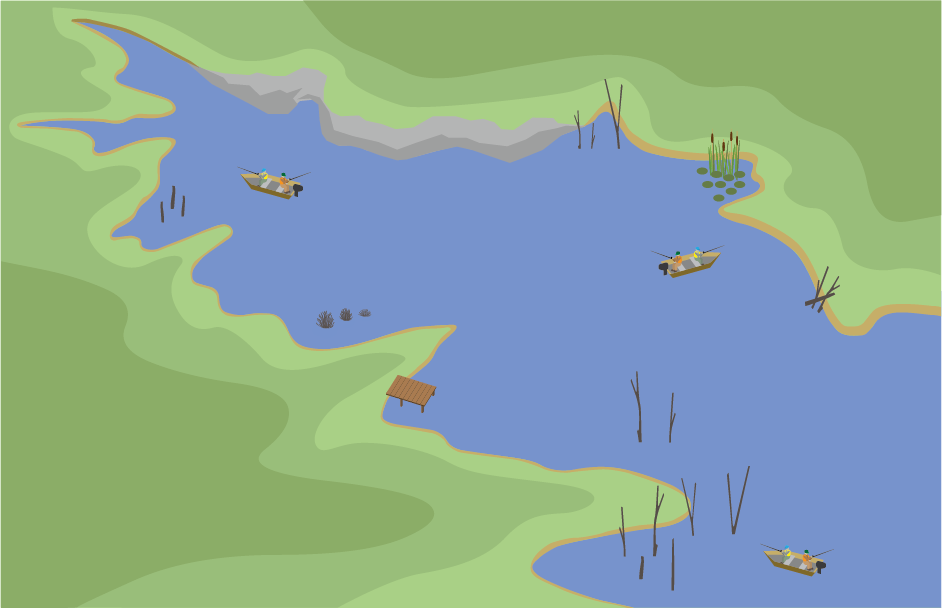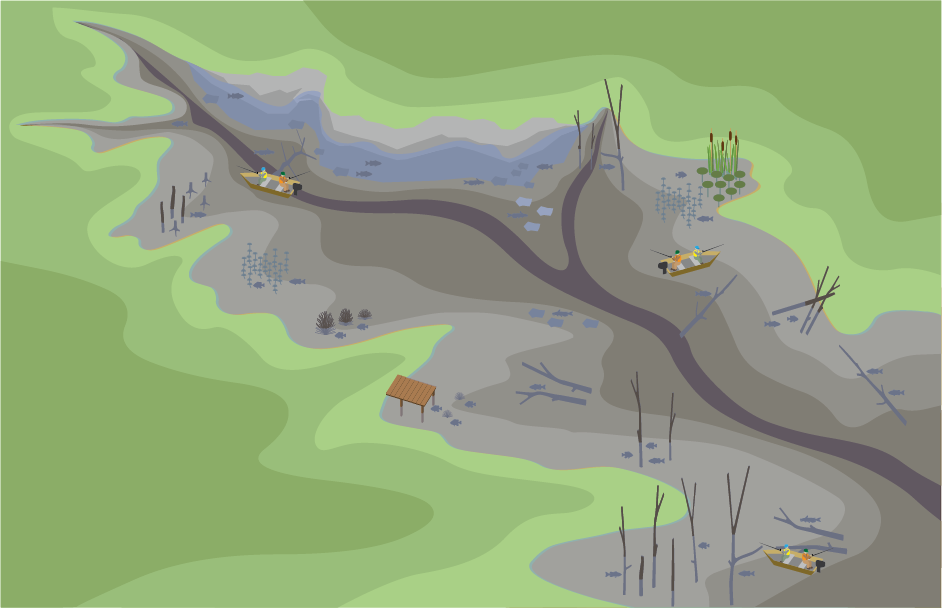Lake Structure
To be successful in catching fish, you have to be able to find the fish and figure out what they will hit. Fish in any lake relate to structure found in that part of the lake. If you fish one particular lake a lot, you probably know where the available structure is, and where the fish can be found. If you fish a new lake or are new to fishing, finding structure and locating fish can sometimes be difficult.
The arm of The Lake illustrated might be found on any lake. This particular arm has many forms of structure which will attract and hold fish. One of the most difficult parts of locating structure is trying to see what’s below the water. With today’s depth sounders, it’s much easier than years ago. But not everyone has a depth sounder or one that will show details of the bottom. A good rule to follow is: (In most cases, the type of structure available above the water can usually be found below the water). The only real way to find out is to either study the lake during low pool periods, study detailed topo maps, use of a depth sounder, or feeling the bottom with a lure.
To learn more about the types of available structure, “Click” on “The Lake’s Structure” tab different parts of the lake or one of the links. A window will appear showing the detail of that area along with a smaller window showing a side view of the area, and information on that type of structure. “Click” on the “Back to Lake Arm” link to return to the lake view.
Feeders
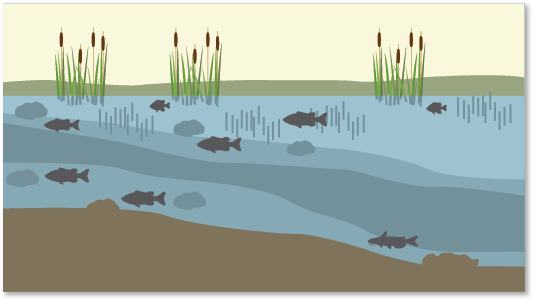 The major lakes in Missouri were created using dams to hold back water from rivers for flood control, hydroelectric production, recreation or all three. Each lake has at least one or two main rivers providing water. To keep the lake level, the same amount of water coming into the lake must be released. This means that the rivers feeding the lake are still active, and are bringing in fresh water and nutrients. The nutrients are usually too small to satisfy the appetites of large fish, but are fine for baitfish, which will bring in the larger gamefish.
The major lakes in Missouri were created using dams to hold back water from rivers for flood control, hydroelectric production, recreation or all three. Each lake has at least one or two main rivers providing water. To keep the lake level, the same amount of water coming into the lake must be released. This means that the rivers feeding the lake are still active, and are bringing in fresh water and nutrients. The nutrients are usually too small to satisfy the appetites of large fish, but are fine for baitfish, which will bring in the larger gamefish.
The main rivers that feed the lake are not the only source of fresh water and nutrients though. There are also the small feeder creeks. These small creeks, which can be found in the back of almost any cove, are dry most of the time. But when it rains, these creeks can flow fast, washing everything that’s settled into them into the lake.
Feeder creeks are an excellent place to find fish after a good rain. Though some lakes muddy up after a rain from dirt that’s washed in from the main rivers or feeder creeks, many lakes have rocky terrains which filter the water. And even if the water is off colored, fish it anyway, the fish can still find the food, and your bait or lure.
When fishing feeder creeks, almost any lure or bait will work. Since the water coming in is not an everyday occurrence, the action is often short lived. But if you can get there when the feeder creeks are active, fishing can be great. If the rains are heavy, most of the water in the lake will usually be held back. The rising lake levels also improve fishing since the flooded shorelines provide more food and cover.
Tip: A WORD OF CAUTION ABOUT FEEDER CREEKS AND RISING LAKE LEVELS. If rains are heavy and last any length of time, be careful when approaching the main rivers or feeder creeks. If flash flood conditions occur, the current can swamp the best of boats or throw it out of control. Shore fishing can also be dangerous, since flash floods can occur and wash the bank from under you. Also with rising lake levels, watch for floating debris in the water, and if your boat is tied down or anchored, be sure that the boat can be released in a hurry. A boat that is tied to a stationary object can be pulled under very quickly during rising water conditions.
Stumps
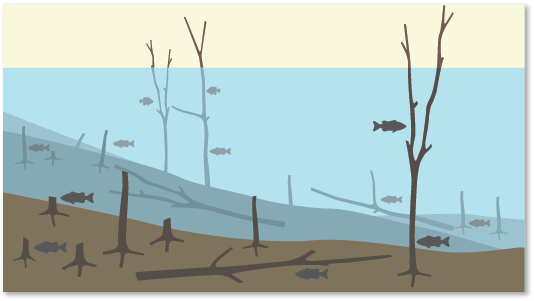 In lakes that have flooded timber, chances are there’s also submerged stumps that provide cover for fish in the area. Stumps are created by trees that have fallen over, or were cut before the lake was flooded. Most of those that were cut, appear in what is called a stump field. These fields are similar to groups of trees, but are usually found in shallower water, and are void of branches.
In lakes that have flooded timber, chances are there’s also submerged stumps that provide cover for fish in the area. Stumps are created by trees that have fallen over, or were cut before the lake was flooded. Most of those that were cut, appear in what is called a stump field. These fields are similar to groups of trees, but are usually found in shallower water, and are void of branches.
Stumps, like trees, serve a purpose to fish in the area. They provide cover, structure, ambush points, a food source area, and protected spawning areas.
Stumps, as with trees, come in different sizes, may be hollow, or have an elaborate root system, all of which may hold fish. During sunny days, fish will most likely favor the shaded side of the stump. Also, if motoring through a stump field, take caution, the lower unit of a boat motor is no match for a sturdy stump.
Tip: When fishing stumps, use lures that can be fished along the sides of the stumps, or right along the top.
Flats
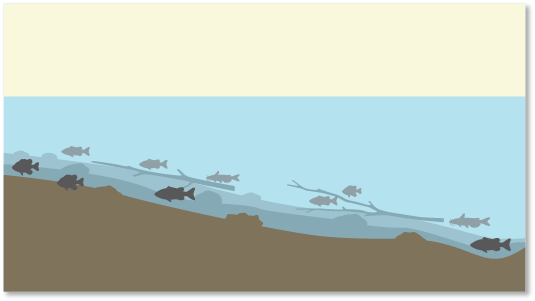 Flats are large usually shallow areas of the lake that gradually increase in depth, then level out for a while before getting deeper. These areas of the lake can be difficult to read and many times not understood. Because flats lack structure and cover found in other areas of a lake, anglers might pass them up.
Flats are large usually shallow areas of the lake that gradually increase in depth, then level out for a while before getting deeper. These areas of the lake can be difficult to read and many times not understood. Because flats lack structure and cover found in other areas of a lake, anglers might pass them up.
Flats can be found at the end of lake arms and usually opposite from bluffs. Though bluffs drop right into the old river channel, flats will also end up there, but travel a lot further distance. A good look at the surrounding bank will give you an idea what type of cover is available on a flat.
Different types of structure and cover found on flats include gravel, rocks, small tress, stumps, brush, and weeds. Because of the shallow water, winds will push baitfish onto them and towards the bank, which in turn attracts gamefish. Weed and algae are often found on flats because of the shallow water and sunlight, which attracts baitfish to feed. Stumps, weeds, logs, and rocks provide cover and ambush points for larger fish, and gravel bottoms can provide spawning areas. The shallow water also makes it more difficult for baitfish to get away from the larger fish.
Because flats can be massive, it’s difficult to fish all the water. For this reason, it’s best to use lures that can cover a lot of water quickly. Once fish are caught, you can concentrate on that or similar areas. Good baits to use when fishing flats are spinnerbaits, shallow running crankbaits, buzz baits, and finally plastic baits and the jig-n-pig. Position yourself to make long casts as to cover as much area as possible. And as with any type of structure, on sunny days, fish the shaded sides of the available cover.
Fish usually use flats during the warmer seasons. Mornings and evenings seems to be best, but on some lakes, fish will stay on the flats all day. On warm days during the Winter months, some fish will venture onto the flats since they warm up fast, so check it out.
Tip: Be careful when running a boat across a flat. Hidden structures can cost your boat a trip to the repair shop. A Carolina rigged plastic bait seems to work well on flats. Since the water is shallow, this will keep the bait off the bottom. Also, a strike is easier to detect since the fish will move to the side rather than down after taking the bait.
Brush
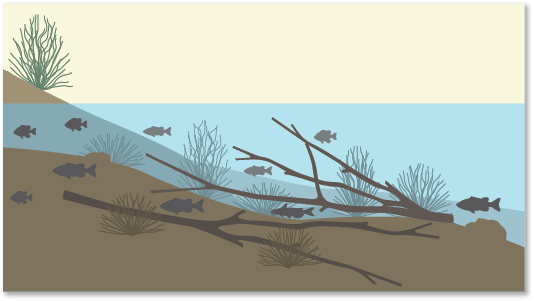 Areas of the lake that have brush often have a mixture of cover including trees, stumps and rocks. bagThe back of this particular cove could considered a mixed bag of cover, or possibly a “Honey Hole”. Though most coves have some of the structure and cover shown, it’s not very often that they have all that’s shown. But they do exist. If you find a place like this, keep it to yourself for a least a little while.
Areas of the lake that have brush often have a mixture of cover including trees, stumps and rocks. bagThe back of this particular cove could considered a mixed bag of cover, or possibly a “Honey Hole”. Though most coves have some of the structure and cover shown, it’s not very often that they have all that’s shown. But they do exist. If you find a place like this, keep it to yourself for a least a little while.
Almost any bait or lure can be used in this type of mixed bag area. It has everything any fish would want, structure, cover, an active creek, vegetation, and access to deep water. The best thing to learn about an area like this, is what kind of fish are using which type of cover. This way, which ever fish your after, you’ll be able to fish that spot and catch what you want. The only drawback to this type of spot is that almost everyone else knows about it and has fished it. Though it may appear to be fished out, take time to study the area. Most people don’t, and some of the smallest of areas can be very productive.
Tip: If you find a place like this, have fun.
Points
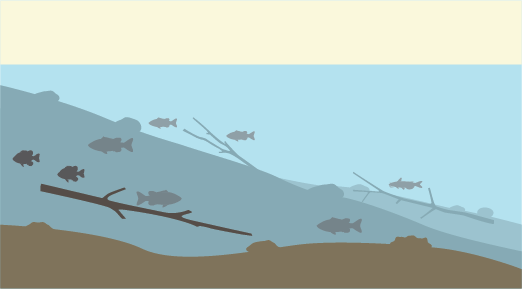 Underwater logs or falldowns are an excellent place to find fish. Aside from the structure element they provide, logs and falldowns provide cover for all fish, and ambush points for larger fish. Logs and falldowns end up where they’re at by a number of ways. Some are placed by fisherman, others float and settle from other areas of the lake, and most common, from trees that have fallen from the bank. If you find falldowns along a bank, it’s a good bet that there are more logs under the water that can’t be seen. A good way to locate logs underwater if you don’t have a fish locator or if fishing from shore, is to cast and retrieve a lure to see if it bumps any logs. Falldowns that enter the water at steeper angles seem to hold larger fish. This may be due to the available cover the falldown provides. Logs that lay flat on the bottom will hold fish, but they seem to be smaller. Other keys areas of the logs and falldowns that will hold fish are the branches and roots. Don’t be afraid to cast into those tangled areas, just use weedless lures.
Underwater logs or falldowns are an excellent place to find fish. Aside from the structure element they provide, logs and falldowns provide cover for all fish, and ambush points for larger fish. Logs and falldowns end up where they’re at by a number of ways. Some are placed by fisherman, others float and settle from other areas of the lake, and most common, from trees that have fallen from the bank. If you find falldowns along a bank, it’s a good bet that there are more logs under the water that can’t be seen. A good way to locate logs underwater if you don’t have a fish locator or if fishing from shore, is to cast and retrieve a lure to see if it bumps any logs. Falldowns that enter the water at steeper angles seem to hold larger fish. This may be due to the available cover the falldown provides. Logs that lay flat on the bottom will hold fish, but they seem to be smaller. Other keys areas of the logs and falldowns that will hold fish are the branches and roots. Don’t be afraid to cast into those tangled areas, just use weedless lures.
If fish are holding tight to cover due to bright light or cold front conditions, logs and falldowns are a good place to look. During these type of conditions, fish may not go very far to chase a bait or lure. For this reason, the presentation of the bait or lure should be as close as possible to the log or falldown.
Logs or falldowns that are found with other types of cover and structure such as gravel, rocks, weeds, or trees, are a greater plus. An area with a concentration of cover can hold a number of large fish. Good baits for fishing logs and falldowns are those used with floats, spinnerbaits, shallow running crankbaits, plastic baits, and the jig-n-pig. Even if someone has fished the log or falldown before you, check it out.
Tip: When fishing a log or falldown, position yourself so that the bait or lure used can be retrieved along the length of the log or falldown. Fewer casts will keep from spooking the fish, and more area can be covered per cast.
Docks
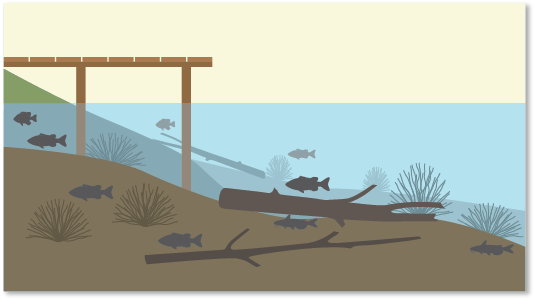 Docks found anywhere on any lake are worth a cast. Since most of the lakes in Missouri were built for flood control, lake levels fluctuate. For this reason, it’s hard to find pier type docks, so most are set on some sort of floatation. Docks on floats are actually more of an advantage to the fisherman. With the absence of piers, lures can be fished under the docks more easily.
Docks found anywhere on any lake are worth a cast. Since most of the lakes in Missouri were built for flood control, lake levels fluctuate. For this reason, it’s hard to find pier type docks, so most are set on some sort of floatation. Docks on floats are actually more of an advantage to the fisherman. With the absence of piers, lures can be fished under the docks more easily.
Docks can serve many purposes for the fish. They provide cover during sunny days, a sense of security, and a surface type structure marker. Since most docks have sunken brush under or around them, they attract baitfish, which in turn attracts larger fish.
When fishing docks, cast all around, underneath, and the areas between docks. Since docks provide cover and a sort of structure, fish will venture to other types of cover and structure near the docks.
Tip: Most floating docks are secured to the shore by a walkway and cables. Many fisherman never take the time to fish the water beneath the walkways and between the cables. The walkways provide shade that fish will take advantage of, and because of the cables, these areas may be untouched on many lakes.
Trees
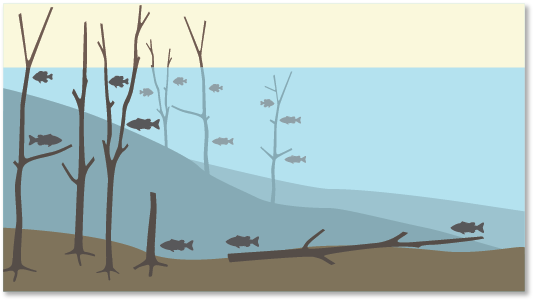 One of the most popular forms of cover and structure to fish are trees. Many of the lakes in Missouri still have flooded timber. Lakes can have trees in water from 1 to 60 feet in depth, this includes trees that are fully submerged and can’t be seen. Trees provide cover in the form of shade, and ambush points for larger fish. They also serve as structure for fish to use and follow, and as a food source area since baitfish will use the branches to hide from predators.
One of the most popular forms of cover and structure to fish are trees. Many of the lakes in Missouri still have flooded timber. Lakes can have trees in water from 1 to 60 feet in depth, this includes trees that are fully submerged and can’t be seen. Trees provide cover in the form of shade, and ambush points for larger fish. They also serve as structure for fish to use and follow, and as a food source area since baitfish will use the branches to hide from predators.
Look for trees along creek channels, old road beds, creeks, points, weed lines, and changing terrain. Boat lanes that were cut before the lake was filled is another place to find trees that fish might use. Though fish can be caught around trees in shallow water, fish can also be taken from trees in deep water, or suspended in trees 5 to 10 feet below the surface.
At times, fish will stay close to trees, almost hugging them. Vertical fishing techniques are needed in these situations. If a tree or group of trees seems like it should hold fish, check it out. Also, even if other fisherman have fished the trees right before you, fish them anyway. Your lure or presentation may be different and be more successful. Also check for fish around other structure or cover near trees, fish may use some trees for initial cover, but then scatter to other locations. If fish are caught from trees using a certain pattern, the same pattern will usually work on other trees in similar locations around the lake.
Tip: When fishing trees, use weedless type lures, or lures with brass hooks that bend easily when pulling from a snag. Also, if fish are being caught from certain types of trees, look for the same type of trees around the lake.
Logs and Falldowns
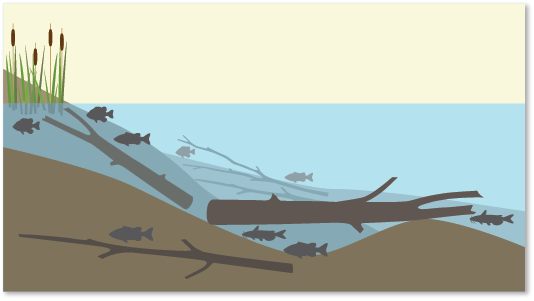 Underwater logs or falldowns are an excellent place to find fish. Theses areas provide cover for all fish, and ambush points for larger fish. Logs and falldowns end up in the lake in a number of ways. Some are placed by fisherman, others float and settle from other areas of the lake, and most common, from trees that have fallen from the bank. If you find falldowns along a bank, it’s a good bet that there are more logs under the water that can’t be seen. A good way to locate logs underwater if you don’t have a fish locator or if fishing from shore, is to cast and retrieve a lure to see if it bumps any logs. Falldowns that enter the water at steeper angles seem to hold larger fish. This may be due to the available cover the falldown provides. Logs that lay flat on the bottom will hold fish, but they seem to be smaller. Other keys areas of the logs and falldowns that will hold fish are the branches and roots. Don’t be afraid to cast into those tangled areas, just use weedless lures.
Underwater logs or falldowns are an excellent place to find fish. Theses areas provide cover for all fish, and ambush points for larger fish. Logs and falldowns end up in the lake in a number of ways. Some are placed by fisherman, others float and settle from other areas of the lake, and most common, from trees that have fallen from the bank. If you find falldowns along a bank, it’s a good bet that there are more logs under the water that can’t be seen. A good way to locate logs underwater if you don’t have a fish locator or if fishing from shore, is to cast and retrieve a lure to see if it bumps any logs. Falldowns that enter the water at steeper angles seem to hold larger fish. This may be due to the available cover the falldown provides. Logs that lay flat on the bottom will hold fish, but they seem to be smaller. Other keys areas of the logs and falldowns that will hold fish are the branches and roots. Don’t be afraid to cast into those tangled areas, just use weedless lures.
If fish are holding tight to cover due to bright light or cold front conditions, logs and falldowns are a good place to look. During these type of conditions, fish may not go very far to chase a bait or lure. For this reason, the presentation of the bait or lure should be as close as possible to the log or falldown.
Logs or falldowns that are found with other types of cover and structure such as gravel, rocks, weeds, or trees, are a greater plus. An area with a concentration of cover can hold a number of large fish. Good baits for fishing logs and falldowns are those used with floats, spinnerbaits, shallow running crankbaits, plastic baits, and the jig-n-pig. Even if someone has fished the log or falldown before you, check it out.
Tip: When fishing a log or falldown, position yourself so that the bait or lure used can be retrieved along the length of the log or falldown. Fewer casts will keep from spooking the fish, and more area can be covered per cast.
Lily Pads and Weeds
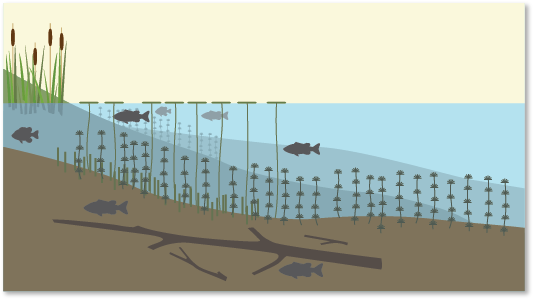 Grass, lily pads, weeds, or any other type of water plant is usually a good place to find fish. Weeds provide a food source for baitfish, which in turn provides the food source for pan and game fish. The lily pads shown, are not readily available in most Missouri lakes, but can be found in smaller lakes and ponds. Most weeds are good, but some can choke a lake or deplete the oxygen, killing off the fish. This does not seem to be a problem in Missouri lakes.
Grass, lily pads, weeds, or any other type of water plant is usually a good place to find fish. Weeds provide a food source for baitfish, which in turn provides the food source for pan and game fish. The lily pads shown, are not readily available in most Missouri lakes, but can be found in smaller lakes and ponds. Most weeds are good, but some can choke a lake or deplete the oxygen, killing off the fish. This does not seem to be a problem in Missouri lakes.
Aside from providing a food source for fish, weeds also provide structure, cover, and ambush areas. Look for weeds along shorelines, channels, points, and gravel beds. The best areas to fish within weed beds are along the edges, holes, and pockets. Some fish will use weeds on gravel beds for spawning to help protect the eggs.
Weeds are not usually found all year around. They will start to show in the Spring, and seem to flourish during the Summer months. During the Fall, weeds will begin to die back. Lakes or areas of lakes with clear water will have more weeds than off colored or murky water. Weeds can also be found in shallow water and to depths of 10 feet or more.
Tip: When fishing weeds or grass, use lures that are of course as weedless as possible, or lures that can be fished on the surface or just above the weeds. Be sure to have strong line, a snagged lure in some weeds is almost as bad as snagging a tree.
Bluffs and Ledges
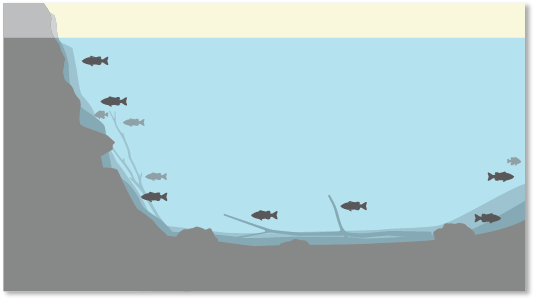 Bluffs and ledges are the result of millions of years of water carving out surrounding rock. What you see above the water is usually the same below the water, nooks, crannies, ledges, and outcroppings. All of which provides excellent cover and hiding places for fish. Bluffs are usually shear and go straight down into the river channel. Looking at the location of bluffs on a lake can give a good idea where the channel runs.
Bluffs and ledges are the result of millions of years of water carving out surrounding rock. What you see above the water is usually the same below the water, nooks, crannies, ledges, and outcroppings. All of which provides excellent cover and hiding places for fish. Bluffs are usually shear and go straight down into the river channel. Looking at the location of bluffs on a lake can give a good idea where the channel runs.
Depending on the lake level, bluffs in Missouri lakes can range from 30 to over 100 feet in depth. Aside from all the hiding places in the bluffs and ledges, other forms of structure and cover that can be found on the bluffs are trees, stumps, falldowns, gravel, and large rocks.
When fishing bluffs, it’s not necessary to fish all the way to the bottom, many fish can be found suspended anywhere along the depths of the bluff. The best lures to use are those that can be fished along the sides of the bluffs such as crankbaits and spinnerbaits, or slow falling lures that can draw the fish from their hiding places such as plastic worms or the jig-n-pig. If the fish are deep, try vertical fishing techniques using jigs or spoons.
Tip: When fishing from a boat, position yourself so that you and your buddy (if you’re fishing with a buddy) can cast parallel to the bluffs. Also, check the water 10 to 20 feet away from the bluffs.

